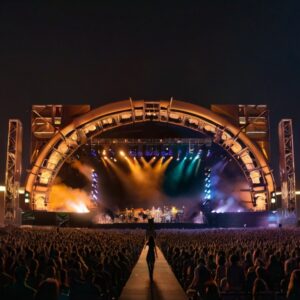 The transformation currently sweeping through the concert halls and live music scenes isn’t merely superficial; it’s a profound metamorphosis that touches the very soul of musical presentation and audience engagement. For decades, the conventional concert format—with its halls of seated silence, formal attire, and an unspoken barrier between the performers and the audience—has been the gold standard. A new wave of creativity is challenging these norms, introducing dynamic and immersive concert experiences that defy expectations. From interactive performances where audiences move freely among the musicians to casual “come-as-you-are” atmospheres that replace stuffy concert halls with vibrant, eclectic venues, these innovative approaches are making classical music more accessible and appealing to a broader audience. By integrating modern technology, such as augmented reality (AR) experiences that enrich performances with visual storytelling, or by embracing unconventional settings, such as outdoor parks, industrial lofts, or even intimate home concerts, organizers and musicians are crafting a new narrative for classical music—one that emphasizes inclusivity, interaction, and the sheer joy of experiencing live music. This evolution is about drawing in those who might typically shy away from classical music and creating a communal space where music becomes a bridge between diverse audiences, encouraging exploration, discovery, and a deeper, more personal connection to the art form.
The transformation currently sweeping through the concert halls and live music scenes isn’t merely superficial; it’s a profound metamorphosis that touches the very soul of musical presentation and audience engagement. For decades, the conventional concert format—with its halls of seated silence, formal attire, and an unspoken barrier between the performers and the audience—has been the gold standard. A new wave of creativity is challenging these norms, introducing dynamic and immersive concert experiences that defy expectations. From interactive performances where audiences move freely among the musicians to casual “come-as-you-are” atmospheres that replace stuffy concert halls with vibrant, eclectic venues, these innovative approaches are making classical music more accessible and appealing to a broader audience. By integrating modern technology, such as augmented reality (AR) experiences that enrich performances with visual storytelling, or by embracing unconventional settings, such as outdoor parks, industrial lofts, or even intimate home concerts, organizers and musicians are crafting a new narrative for classical music—one that emphasizes inclusivity, interaction, and the sheer joy of experiencing live music. This evolution is about drawing in those who might typically shy away from classical music and creating a communal space where music becomes a bridge between diverse audiences, encouraging exploration, discovery, and a deeper, more personal connection to the art form.
Unconventional Venues
The shift to unconventional venues is revolutionizing the classical music scene, infusing it with fresh energy and a sense of boundless possibility. Envision a scenario where the harmonious strains of a cello resonate through the cool air of an ancient cave, or the vibrant notes of a violin soar amidst the rusted beams of an old factory, transforming these spaces into living, breathing entities of sound. These environments provide a backdrop and become an integral part of the performance, imbuing each piece with unique acoustics and a distinct atmosphere that cannot be replicated within the pristine walls of traditional concert halls. These novel settings invite audiences who might not consider attending a classical concert. People who happen upon a performance in a public park or are curious about a classical night in a local pub are introduced to the genre in a context that feels more relaxed and welcoming. Musicians and ensembles are leveraging these spaces to break down the barriers of perceived inaccessibility surrounding classical music, emphasizing that it is, in fact, a genre that transcends age, class, and culture. This trend democratizes the access to classical music and enriches the communal and cultural landscape, making high-quality performances an integral part of the social and environmental fabric of communities. Through these innovative endeavors, classical musicians are seeking new audiences—they are actively crafting new experiences that redefine the essence of a concert, thereby fostering a growing appreciation for classical music in the most unanticipated places.
Interactive Concerts
Interactive concerts represent a transformative leap in how audiences experience classical music, turning traditional performances into immersive events where every attendee plays a part in shaping the evening. Imagine entering a venue where you’re a co-creator of the night’s journey. At such events, the audience might influence the flow of the concert by selecting compositions from a digital menu, shared via an app or announced from the stage, leading to a performance that is truly of the moment and reflective of the collective mood. This innovative use of technology bridges the gap between stage and seats, crafting a concert experience that is vibrantly alive and unpredictably delightful.
The interaction extends beyond mere selection, inviting audiences to contribute artistically. This could manifest as drawing or painting in response to the melodies and harmonies swirling in the space, writing poetry inspired by the crescendos and decrescendos, or even moving in interpretive dance as the music dictates the tempo. Such multi-disciplinary approaches enrich the concert experience but also highlight the universal language of the arts, merging visual, literary, and performing arts in a symphony of creative expression.
Integrating Q&A sessions or discussions into the concert format breaks down the historical pedestal upon which performers have been placed, humanizing the artists and demystifying the creative process. This dialogue between musicians and audience fosters a deeper appreciation and understanding of the music, its origins, and its relevance. Attendees leave with the memory of beautiful music but with new insights and a personal connection to the artists and compositions.
This engaging and inclusive approach to classical music performances is key in not only retaining existing aficionados but also in lighting the spark of curiosity and passion in new listeners. People who once viewed classical music as an exclusive or intimidating genre discover a welcoming and exhilarating community, where each concert is heard and felt and lived. By turning the concert into a collaborative event, performers and audiences together create a sense of belonging and a shared experience that transcends the notes played, making classical music accessible and appealing to a broad and diverse audience.
Incorporating Multimedia Elements
Welcome to the era where concerts are no longer just about sound. The integration of multimedia elements – from intricate light shows to immersive video projections – is carving a new niche in classical music performances. By transforming concerts into multi-sensory experiences, musicians can tell stories, evoke emotions, and convey messages with a richness and depth that music alone might not achieve.
Visuals can be particularly effective in illustrating the narrative behind a piece, making classical music more accessible to those unfamiliar with its language. If it’s projecting abstract art that evolves with the music or syncing up dramatic lighting effects to highlight a composition’s climax, multimedia elements can significantly enhance the emotional impact of a performance.
